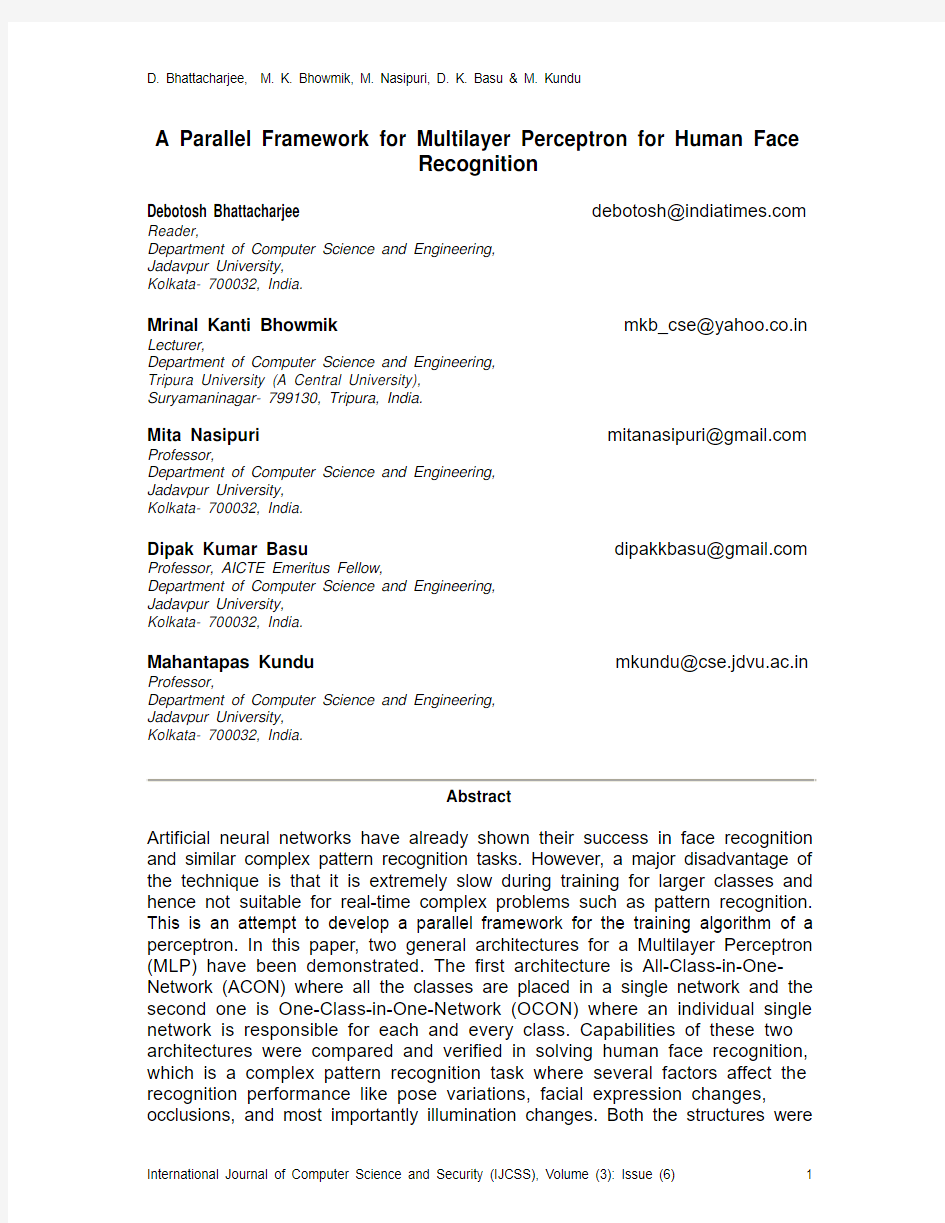人脸识别英文文献

- 1、下载文档前请自行甄别文档内容的完整性,平台不提供额外的编辑、内容补充、找答案等附加服务。
- 2、"仅部分预览"的文档,不可在线预览部分如存在完整性等问题,可反馈申请退款(可完整预览的文档不适用该条件!)。
- 3、如文档侵犯您的权益,请联系客服反馈,我们会尽快为您处理(人工客服工作时间:9:00-18:30)。
A Parallel Framework for Multilayer Perceptron for Human Face
Recognition
Debotosh Bhattacharjee debotosh@ Reader,
Department of Computer Science and Engineering,
Jadavpur University,
Kolkata- 700032, India.
Mrinal Kanti Bhowmik mkb_cse@yahoo.co.in Lecturer,
Department of Computer Science and Engineering,
Tripura University (A Central University),
Suryamaninagar- 799130, Tripura, India.
Mita Nasipuri mitanasipuri@ Professor,
Department of Computer Science and Engineering,
Jadavpur University,
Kolkata- 700032, India.
Dipak Kumar Basu dipakkbasu@ Professor, AICTE Emeritus Fellow,
Department of Computer Science and Engineering,
Jadavpur University,
Kolkata- 700032, India.
Mahantapas Kundu mkundu@cse.jdvu.ac.in Professor,
Department of Computer Science and Engineering,
Jadavpur University,
Kolkata- 700032, India.
Abstract
Artificial neural networks have already shown their success in face recognition and similar complex pattern recognition tasks. However, a major disadvantage of the technique is that it is extremely slow during training for larger classes and hence not suitable for real-time complex problems such as pattern recognition. This is an attempt to develop a parallel framework for the training algorithm of a perceptron. In this paper, two general architectures for a Multilayer Perceptron (MLP) have been demonstrated. The first architecture is All-Class-in-One-Network (ACON) where all the classes are placed in a single network and the second one is One-Class-in-One-Network (OCON) where an individual single network is responsible for each and every class. Capabilities of these two architectures were compared and verified in solving human face recognition, which is a complex pattern recognition task where several factors affect the recognition performance like pose variations, facial expression changes, occlusions, and most importantly illumination changes. Both the structures were
implemented and tested for face recognition purpose and experimental results show that the OCON structure performs better than the generally used ACON ones in term of training convergence speed of the network. Unlike the conventional sequential approach of training the neural networks, the OCON technique may be implemented by training all the classes of the face images simultaneously.
Keywords:Artificial Neural Network, Network architecture, All-Class-in-One-Network (ACON), One-Class-in-One-Network (OCON), PCA, Multilayer Perceptron, Face recognition.
1. INTRODUCTION
Neural networks, with their remarkable ability to derive meaning from complicated or imprecise data, can be used to extract patterns and detect trends that are too complex to be noticed by either humans or other computer techniques. A trained neural network can be thought of as an "expert" in the category of information it has been given to analyze [1]. This proposed work describes the way by which an Artificial Neural Network (ANN) can be designed and implemented over a parallel or distributed environment to reduce its training time. Generally, an ANN goes through three different steps: training of the network, testing of it and final use of it. The final structure of an ANN is generally found out experimentally. This requires huge amount of computation. Moreover, the training time of an ANN is very large, when the classes are linearly non-separable and overlapping in nature. Therefore, to save computation time and in order to achieve good response time the obvious choice is either a high-end machine or a system which is collection of machines with low computational power.
In this work, we consider multilayer perceptron (MLP) for human face recognition, which has many real time applications starting from automatic daily attendance checking, allowing the authorized people to enter into highly secured area, in detecting and preventing criminals and so on. For all these cases, response time is very critical. Face recognition has the benefit of being passive, nonintrusive system for verifying personal identity. The techniques used in the best face recognition systems may depend on the application of the system.
Human face recognition is a very complex pattern recognition problem, altogether. There is no stability in the input pattern due to different expressions, adornments in the input images. Sometimes, distinguishing features appear similar and produce a very complex situation to take decision. Also, there are several other that make the face recognition task complicated. Some of them are given below.
a) Background of the face image can be a complex pattern or almost same as the color of the
face.
b) Different illumination level, at different parts of the image.
c) Direction of illumination may vary.
d) Tilting of face.
e) Rotation of face with different angle.
f) Presence/absence of beard and/or moustache
g) Presence/Absence of spectacle/glasses.
h) Change in expressions such as disgust, sadness, happiness, fear, anger, surprise etc.
i) Deliberate change in color of the skin and/or hair to disguise the designed system.
From above discussion it can now be claimed that the face recognition problem along with face detection, is very complex in nature. To solve it, we require some complex neural network, which takes large amount of time to finalize its structure and also to settle its parameters.
In this work, a different architecture has been used to train a multilayer perceptron in faster way. Instead of placing all the classes in a single network, individual networks are used for each of the
